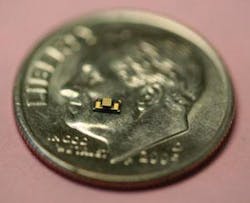Nextreme offers electro-optics and microelectronics cooler for military applications
DURHAM, N.C. - Nextreme Thermal Solutions in Durham, N.C., is introducing the Ultra-High Packing Fraction (UPF) OptoCooler thermoelectric module for cooling and temperature-control requirements for electro-optics, electronics, medical, military, and aerospace applications.
The module has been optimized for laser diode, LED, and advanced sensor products, company officials say. The UPF OptoCooler removes a maximum of 420 milliwatts of heat at 25 degrees Celsius ambient temperature in an active footprint of 0.55 square millimeters.
As a result, the module can pump a heat density of as much as 78 watts per square centimeter at 85 C; these values increase to 610 milliwatts and 112 watts per square centimeter, respectively. The module was developed in response to demand for microscale cooling solutions that improve the performance of electronics without sacrificing efficiency.
With Nextreme’s thin-film thermal bump technology at its core, the OptoCooler can be integrated into electronic and optoelectronic packaging to deliver more than 45 C of cooling. The module can be embedded within laser diode packages-devices that illuminate telecommunications fiber-optic cables-to control temperatures, for example.
Nextreme is offering this tiny thermoelectric module for cooling components in electro-optics and electronic systems.
“This is a major breakthrough,” says Dave Koester, vice president of engineering at Nextreme. “For example, this development enables direct cooling of a laser diode on a scale that is similar to the diode itself. This significantly improves efficiency and offers new, integrated packaging options that were previously unavailable.”
The UPF OptoCooler module serves as Nextreme’s unit building block for all discrete products in the future. It is manufactured in high volumes with Nextreme’s thermal copper pillar bump process-a process that is based on an established electronic packaging approach that scales well into large arrays.
The thermal copper pillar bump process integrates thin-film thermoelectric material into the solder bumped interconnects that traditionally provide mechanical and electrical functionalities in today’s high-performance/high-density integrated circuits. Unlike conventional solder bumps, Nextreme bumps function as solid-state heat pumps on a microscale.
The thermal bumping process can be implemented at the system level, package level, or wafer level, and also in discrete modules as demonstrated by Nextreme’s newly available OptoCooler. For more information, visit Nextreme online at www.nextreme.com.

